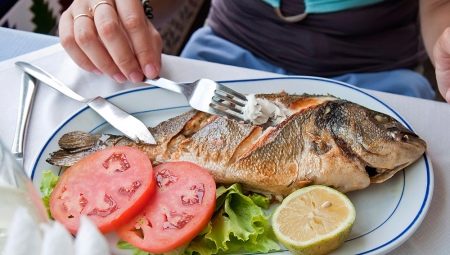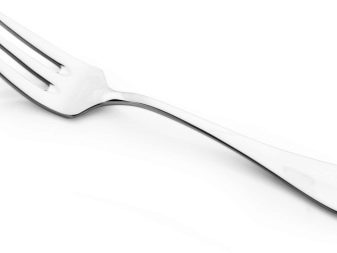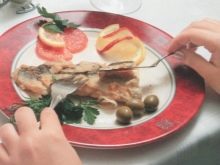How to choose a fish fork?

The rules of conduct at the table imply the use of a certain amount of cutlery. Trying to determine the purpose of this or that subject, one may encounter certain difficulties. Nevertheless, in modern society, a person needs knowledge about the purpose of different cutlery. If fish dishes are present at a gala lunch or dinner, then fish forks will certainly be included when setting the table.

What does it look like?
Initially, the fish fork had only three prongs, rather wide and not sharp. In length, it is significantly shorter than the classic conventional fork, its handle is wider and flatter.
Now they can also make forks for fish and with four prongs. But it will still not work to be confused with a regular fork, since the teeth are shorter, and in order to make it easier to extract the bones, a characteristic slot is located in the center.
For serving, both types of forks are used in the same way.


Initially, the sets that featured fish forks consisted of a significant number of items. They were available only to the elite strata of society. Therefore, they were made from valuable metals and their alloys. Silver and even gold table sets were common among the aristocracy.
Now you can also purchase similar exclusive services, but those made of stainless steel are more widespread. Handles can be decorated with various patterns and gold or silver plating.


Varieties
Despite the fact that the fish fork is often replaced by a dining room, at large events and formal dinners it is present in the serving. It is customary for them to use not only fish dishes, but also seafood, as well as canned fish.
- Chill forks (fr. Sink). In France, a chill mold was a special metal dish for hot fish dishes. In it they cooked and served food to the table. Accordingly, the fork with which this dish was served began to be called chill. Basically, it is the main cutlery for fish treats. This is the same fork with short teeth and a notch for bone extraction.
- Canned food fork. Special accessory device. With the help of it, they do not eat, but transfer pieces of fish from the common dish onto their plate. It is a stylized fork-spatula with five teeth, which are interconnected along the edge. Thus, excess oil passes through the slots, and the wide base helps to gently pick up and transfer a small fish, whole or a piece, onto a plate.
- Double-arm. As the name implies, this device has two teeth, long and sharp. Designed for cold fish appetizers, you can chop pieces of herring or red fish and transfer to an individual plate.
- For a seafood cocktail. A fork in the shape of a trident. The denticles are curved towards the center. There are also other variants of this plug. For example, a device designed for mussels and oysters has a thickened left clove to make it easier to separate the flesh from the shell. A two-pronged long fork is served with crayfish, crabs and shrimps.




And for butchering lobster, there is a double-sided spatula. From one end it is sharp, the shell is cut with it and the meat is taken out of the claws. The other is blunt, in the shape of a scapula for scooping up juice.


How to use?
Chill forks are usually paired with a fish knife. With the help of it, you can aesthetically and conveniently cut the carcass. When serving, the fish fork is placed on the left, the second in a row after the table fork. The fish knife is also the second, but on the right, right after the table knife.
The fish knife is shaped like a scapula. It is not sharp, there are small indentations on the edge of the blade. The knife is not intended for cutting, it only helps to separate the fillets from the bones. If there is no fish knife on the table, then it is allowed to use, instead of it, another fork - fish or table.
Since fish cutters are varied and can be served in many different ways, the rules for their use differ slightly.



So, if the serving contains a set consisting of a fish fork and a fish knife, take the fork in the left hand, and the knife in the right. As mentioned earlier, they do not cut with a knife, but only carefully separate the bones from the fillets, holding a piece of fish with a fork.
First, you should eat the meat from the top of the fish, then you can gently turn over the portioned piece and proceed to the other side.
Small bones are often present in fish dishes, even if you are served a processed fillet. Such bones cannot be pulled out by hand - this is a violation of the rules of etiquette. If you suddenly feel a fish bone in your mouth, then you need to carefully move it with your tongue to your lips and remove it from your mouth with a fork. Then it can be transferred to a specially designed dish or on the edge of your plate.

If, when setting the table, the fish knife was replaced with a classic table fork, then the fish fork is placed on the right side of the plate. Since it now functions as a fish knife. Thus, a table fork is in the left hand, and the meat is separated from the bones with a fish fork. The portioned pieces should be brought to the mouth with the device in the left hand.
There are times when fish dishes are served, but there are no special devices. Then it is difficult to figure out which fork to use for these foods. If this happens, then it is permissible to use a regular fork and a slice of bread. We take the bread in our left hand and hold the fish on a plate, and with a table fork we cut and send portioned pieces into the mouth.
All of the above methods comply with the rules of etiquette and will give confidence at festive feasts. However, they are suitable for hot fish dishes.

There are slight nuances when serving cold pickled or salted fish snacks such as salmon, sturgeon, herring. In this case, in order to cut the fish, take a regular snack knife. The thing is that the carcasses of these types of fish are quite tough. The appetizer knife is on the right side of the plate, at the very end of the serving set.
The variety of fish dishes has led to the emergence of a wide range of cutlery: a variety of tongs, skewers, knives, spoons.
All of them will help you to eat all kinds of fish delicacies beautifully and conveniently.


For information on how to eat fish in a restaurant, see the next video.


